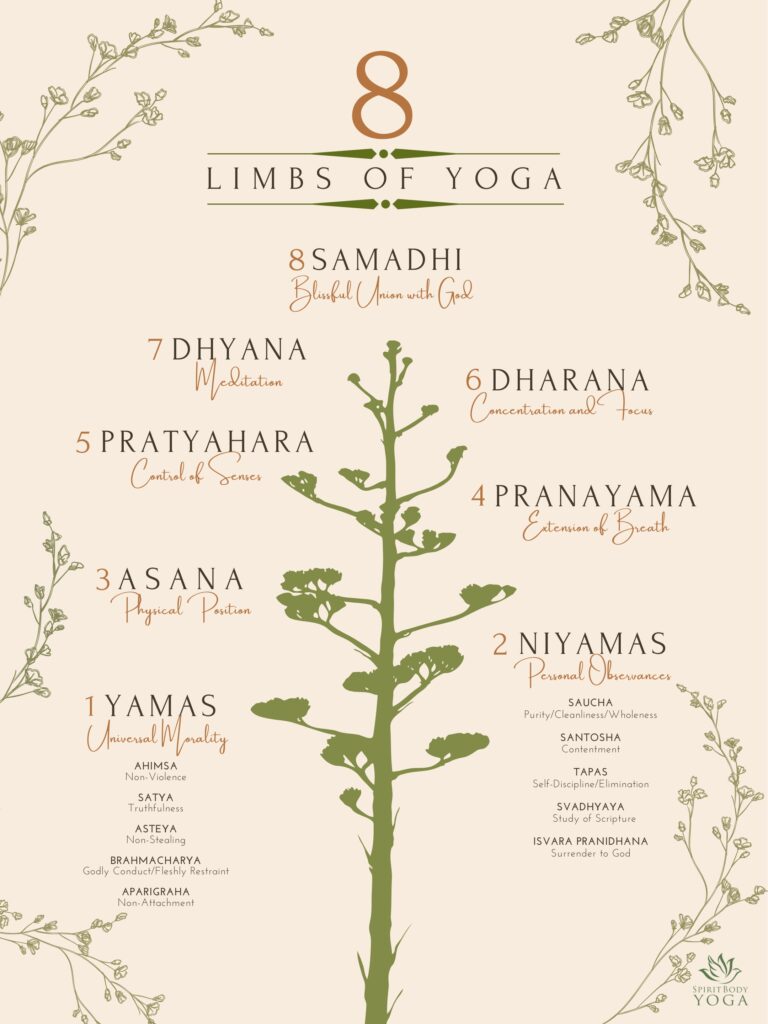Samadhi, is the heart of yoga’s eight-limbed path. It is at the very top of the “yoga tree” and is often described as the highest goal of yoga: perfect stillness, BLISS, and unity. This “BLISS” is complete oneness with the Divine. Samadhi is pointing us to the ultimate goal of being human: union with our Creator.
The term Yoga (Sanskrit: योग) is derived from the term “Yuj”, which means “to yoke” or “union”. Samadhi is not a chasing after God, but resting in the truth that God is already here, dwelling with us.
God has already made Himself available to us, but we have to get “ourselves” (our ego) out of the way. There are many barriers and stumbling blocks that the world around us erects which prevent this union from taking place. The 8 Limb path of Yoga is a roadmap to help us.
Yoga is a science (not a religion) that works to guide us and remove the barriers.
Science is the systematic study of the natural world through observation, experimentation, and analysis. It seeks to discover, organize, and explain knowledge about how things work, often using testable explanations and predictions.
This science is visualized in the form of a tree that you climb to reach the top. At the top is Samadhi.
Here is an outline of Yoga’s scientific path:
The 1st limb on the “yoga tree” is Yama (Universal Morality), and it has 5 branches:
- Ahimsa – Non-Violence
- Satya – Truthfulness
- Asteya – Non-Stealing
- Brahmacharya – Godly Conduct/Fleshly Restraint
- Aparigraha – Non-Attachment
The 2nd Limb is Niyama (Personal Observances) and it also has 5 branches:
- Saucha – Purity/Cleanliness/Wholeness
- Santosha – Contentment
- Tapas – Self-Discipline/Elimination
- Svadhyaya – Study of Scripture
- Isvara Pranidhana – Surrender to God
The 3rd Limb is Asana (Physical Position/Seat)
The 4th Limb is Pranayama (Extension of Life-force/Breath Control)
The 5th Limb is Pratyahara (Control of Senses)
The 6th Limb is Dharana (Concentration and Focus)
The 7th Limb is Dhyana (Meditation)
The 8th Limb is Samadhi (Blissful Union with God)

Understanding Samadhi in Yoga
In traditional yoga circles, Samadhi is often understood as the culmination of practice, the moment when distractions fall away, the mind becomes still, and the practitioner experiences complete absorption into the Divine.
There are even different levels of Samadhi described in yogic philosophy: from fleeting glimpses of bliss to the deepest, most lasting awareness of oneness.
Practically speaking, the journey is cultivated through discipline (the yamas and niyamas), physical practice (asana), breathwork (pranayama), the inner work of sensory control (pratyahara), concentration (dharana), meditation and contemplation (dhyana). Each limb works in a distinct way to prepare the body, mind, and spirit to release worldly attachments and rest in a state of undivided presence with God.
For many yogis, Samadhi represents liberation from suffering, the stilling of the restless mind, and a return to our true essence. It is the pinnacle of spiritual practice: the releasing of ego, fear, anxiety, bitterness, resentment, rage, and self-seeking. Completely releasing selfishness; the releasing of our worldly nature and reaching for the divine.
The Samadhi Journey
Samadhi is less about chasing an elusive state and more about waking up to what is already true: God is with us. We begin to realize that God has always been there but we have not been paying attention.
As a Christian, Samadhi resonates deeply with me because it describes what the Bible says we were created for: union with God. For Jesus came to yoke with us, and to remove the barriers between us and God, because God loves us so much (John 3:16).
Where traditional yoga speaks of “yoking” to the Divine, Scripture reveals the fulfillment of this longing in Jesus, who is Himself the Way, the Truth, and the Life (John 14:6).
The call of Samadhi, oneness, is exactly what Jesus prayed for all of us:
“I am praying not only for these disciples but also for all who will ever believe in me through their message. I pray that they will all be one, just as you and I are one, as you are in me, Father, and I am in you. And may they be in us so that the world will believe you sent me. I have given them the glory you gave me, so they may be one as we are one. I am in them and you are in me. May they experience such perfect unity that the world will know that you sent me and that you love them as much as you love me.” – John 17:20-23
This prayer shows us that union with God is not something we climb toward on our own, but we are held, guided, and carried along the way.
The traditional yoga path clears distractions by following universal morality and specific personal observances. The Bible echos this path by calling us to follow the teachings of Jesus which align with the limbs on the yoga tree: to release sin, pride, selfishness, and the grip of the world so we may abide more fully in His presence.
The beauty is that Samadhi doesn’t point us away from our faith; it aligns perfectly with God’s desire for us. Stillness, meditation, surrender, and devotion are not foreign to Christianity; they are the very heartbeat of walking with Jesus. I will go even further to say that the true-self’s desire of every human being is to be in communion with the One who created them. But to truly see this, we must remove all the distractions of life out of the way.
Living in Samadhi Today
So how do we remove the distractions and live in this state of divine union? We may not experience constant bliss every moment of every day, but we can practice turning our hearts back to the truth that God is already with us.
- Through prayer and meditation, we quiet our minds and listen for God’s still, soft voice. Even if you are unsure of your religious path, God is still there to connect with you, answer your questions, and show you divine love.
- Through breath, we remember the Bible verse Job 33:4: “The Spirit of God has made me, and the breath of the Almighty gives me life.” Even if you don’t know this verse, when you pause to connect to your breath, you instantly cultivate gratitude, knowing deep in your spirit that life is a gift!
- Through stillness, we make space to simply be with God, not striving, but receiving. Samadhi is relationship; it is listening for the wisdom of God and resting in God’s Love.
- Through daily surrender, we echo Jesus’ teachings of non-vilence, truthfulness, non-stealing, being eternally minded, studying scripture, surrender, releasing control of the body’s senses, and caring for the body as a sacred place for God to dwell in.
Samadhi, then, becomes not just a fleeting experience on a yoga mat, but a way of life and a posture of the soul resting in God’s commandments and love.
The Ultimate Bliss!
At the highest point of the yogia tree stands Samadhi, the crown jewel of the eight limbs, the blissful union with the Divine, where striving ceases, the restless mind grows still, and only pure presence remains.
Samadhi is not just an elevated state of consciousness, it is the eternal reality of communion with our Creator. This is the “fullness of joy” Psalm 16:11 speaks of and the unity Jesus prayed for in John 17.
“You make known to me the path of life; you fill me with the fullness of joy in your presence, with eternal pleasures at your right hand.” Psalm 16:11
The ultimate bliss isn’t an abstract state we achieve by effort, but it is a relationship we receive by grace. It’s knowing we are fully loved, completely secure, and forever united with our Creator. It is the resting in divine love, not just for a moment of meditation, but for all of eternity.
The promise of ultimate Samadhi is where every tear is wiped away, every distraction removed, and every heart fully alive in the presence of God (Revelation 21). Until that day, we practice abiding, surrendering, and breathing in His nearness through our daliy yoga practice.
The path of yoga points us toward union where we are able to connect, listen for God’s truth, and rest in Divine love. That is the ultimate bliss!


Leave a Reply